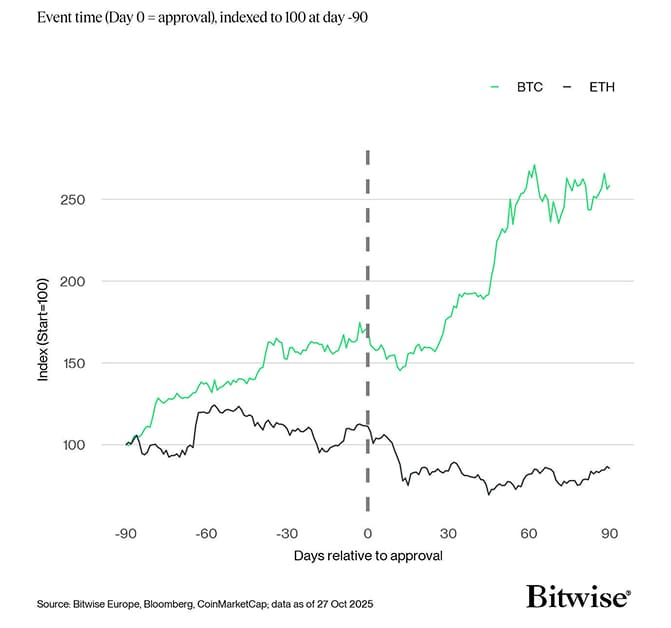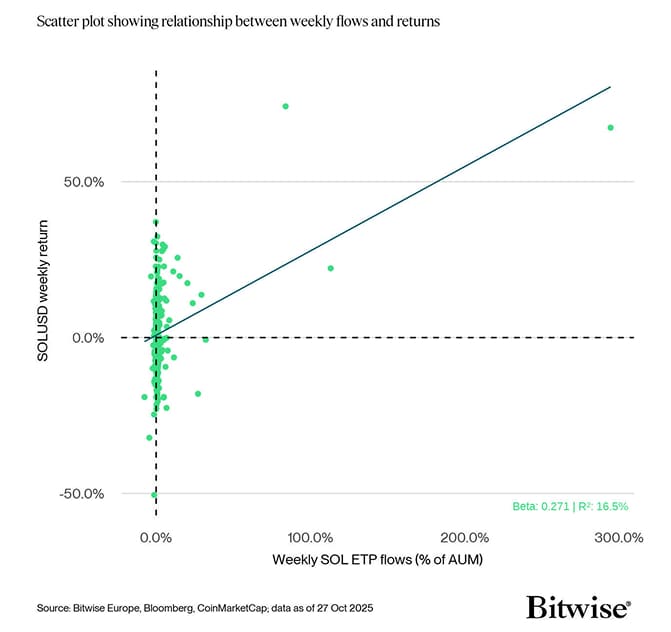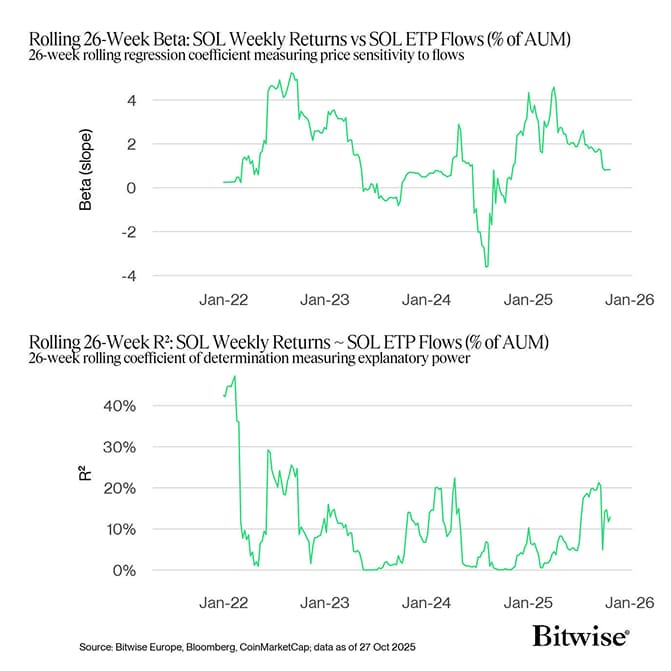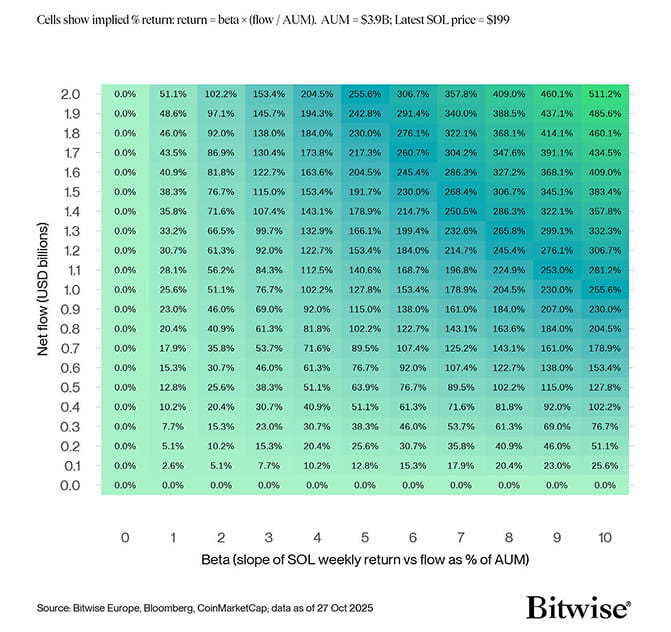- Under the simplifying assumption of today’s current market conditions, and that the current flow-to-price multiplier (1.5x) remains unchanged, a $1bn net flow would correspond to ~34% increase in price.
- We expect the relationship between fund flows and price action to increase as the asset institutionalises.
- Prior spot crypto ETF SEC approvals have historically been “Sell the News” events.
Introduction
The approval of spot Bitcoin (BTC) and Ethereum (ETH) exchange-traded funds (ETFs) in the United States-on January 11 2024 and July 24 2024 respectively-was nothing short of historic. These events marked a sea-change in the legitimacy of crypto as a portfolio asset, accelerating institutional adoption and cementing digital assets as part of mainstream finance.
While Europe had long been more open to crypto exchange-traded products (ETPs), the U.S. had lagged under the, arguably, destructive and political stewardship of regulators like Jay Clayton and Gary Gensler. Clayton was a conservative sceptic, but Gensler turned his “crypto savvy” know how into adversarial combat. After being backed into a corner with legal losses and a soured reputation, the SEC approved both assets which represented a definitive regulatory green light.
Applications for Solana ETFs follow the path set by spot Bitcoin and Ethereum ETFs, using the same Commodity-Based Trust Share framework and leaning on surveillance-sharing arrangements tied to CME Solana futures.
SOL is the 6th largest crypto by market cap (~$110bn) but has a more liquid and larger CME futures market than its closest competitor, XRP (5th largest market cap; ~$157bn), at >$100m per day, and on average $266m per day in July 2025. SOLs CME futures market should be enough evidence to quell the SEC's concern over “manipulation of a non-regulated market of significant size”.
This comes after the Generic Listing Standards which allows companies to launch funds at a “click-of-a-button”, given they meet the standards. This doesn't necessarily provide an automatic tailwind for assets, but it does professionalise crypto assets from an “obscure coin with linked wallets on the blockchain” to a “ticker anyone can access with a brokerage account.” Priming assets to rip when fundamentals and sentiment converge from Trad-Fi.
This Crypto Market Espresso aims to decipher whether SOL's future ETF approval will have an impact on SOL's price.
SEC Approvals Are “Sell the News” Events
Price action following these approvals suggests that ETF launches, despite their long-term bullish implications, can be “sell the news” events in the short run. Both assets traded downwards then reversed higher at the approximately 2 weeks following the approval.
- BTC's approval (Jan 2024): BTC had already rallied ~1.75x in the 90 days before the event, as the market priced in approval well ahead of time, as well trading with strong momentum having entered the second year of its 4-year cycle. The pullback was a classic case of profit-taking after a strongly telegraphed event.
- ETH's approval (Jul 2024): Ethereum showed more confused price action, moving sideways in the lead up to the approval. The market was less convinced of ETH's ETF impact-partly because flows into BTC ETFs were still modest at the time, leaving uncertainty around whether ETFs could structurally transform demand.
BTC and ETH Price Performance Around Spot ETF Approvals

Both assets eventually benefited from ETF legitimacy, but the initial reaction reflected a market that had front-run the decision.
History Never Repeats, But It Does Rhyme.
If history is a guide, SOL may see a similar pattern when its ETF is approved: a short-term dip or muted reaction, followed by long-term structural support. The approval has been widely discussed and anticipated, making it unlikely to be a complete surprise, especially since one single ETF has already been approved.
The relationship between SOL ETP flows (as % of AUM) and SOL's returns shows an average beta of 0.269, which means on average, a 1% inflow into SOL ETPs (relative to AUM) is associated with a +0.269% move in SOL weekly returns.
But the R² of just ~16.5% means flows explain less than a fifth of overall return variation across the full sample of observations. In other words, while there is a directional relationship, most of SOL's price movement is likely mostly driven by factors outside the scope of this analysis.
Most data points are tightly clustered near zero flows, with a few extreme weeks (outliers, 50–300% flows) that drive the regression line upward. This suggests the relationship is heavily influenced by big ETP flow events, not by “normal” weeks.
Our sample size has 13 SOL tickers, ranging from a data set of 1041 days, VSOL SW Equity (21/09/2021), to 82 days, SSK US Equity, i.e. the first SOL staking ETF. The net fund flows data is aggregated by week since each tickers inception.
SOL Weekly Returns vs SOL ETP Weekly Flows (% of AUM)

Solana ETP Flows Are Growing but Still Secondary
Flows into global Solana ETPs have grown sharply since Q4 2024, especially over the last couple of months, with total assets under management (AUM) now at around $3.9bn. This represents meaningful institutional traction but remains small relative to Bitcoin and Ethereum.
In Q4 2024, during the run-up to Trump's election victory, Solana outperformed as it became the preferred blockchain for meme coin launches. Pump.fun, the meme coin launchpad that defined this cycle, is built on Raydium, Solana's leading DEX. During peak retail engagement, Solana captured close to 90% of all DEX volume. Meme coins accounted for a significant share of activity, and Solana's ecosystem benefited disproportionately. While ETP flows helped, they were never the dominant driver.
Even at current levels, flows explain more of SOL's price movement than ever before (with explanatory power rising to ~20% in 2025), but retail dynamics still dominate. Two key reasons stand out:
- SOL remains a retail-led asset. It has been the foundational layer for the meme coin mania, with a large share of its volumes tied to token launchpads.
- Institutional flows are small in absolute terms. With ~$3.9bn in total ETP AUM, SOL is still a high-beta, high-risk asset sitting far out on the risk curve for traditional finance portfolios. Institutions are participating, but not at scale.
The Market is not interested in, and underprices, SOL ETP Flows

In the early bear market (2022), rolling R² spiked as above 40% and beta remained positive. This reflected a period where redemptions and falling prices moved together-flows and returns were tightly linked, and contemporaneous beta showed up as positive because both were being driven by forced selling or capitulation. Price declined ~77% in the first six months of 2022.
As the bear market progressed into 2023, and prices fell another ~77% by year end, beta drifted toward zero and at times turned negative, while R² fell to very low levels. This suggests that inflows were often “sticky” or contrarian-investors averaging into weakness even as prices continued to decline. In this phase, flows rose while returns fell, producing negative β values. Market action was dominated more by external shocks-such as the FTX collapse and broad liquidity stress-than by ETP flows.
By contrast, the bull market of 2024–25 shows a different picture. Beta was broadly positive, with R² in the 10–20% zone. Here, flows tended to chase and amplify upside: creations and fresh allocations reinforced rallies, and while flows were not the sole driver of performance, they became price-relevant during periods of high beta and non-trivial R². Occasional negative beta surges in this period usually lined up with pullbacks or rebalancing events, such as creations catching up after prior gains or redemptions during short-term corrections.
How Net Flows Could Impact Price
Under the simplifying assumption of today's current market conditions, and that the current flow-to-price multiplier (1.5x) remains unchanged, a $1bn net flow would correspond to ~38% increase in price.
Note that this sensitivity table is purely contemporaneous and it doesn't carry any uncertainty (neither R² nor confidence/prediction intervals) into the price-impact numbers.
SOL performance sensitivity to ETP net flows

Allocation Implications
ETP flows have had varying influences of SOL's price action over the last ~3.5years. Most of the variation in price can be explained by factors outside of the scope of this analysis.
Yet, we believe Solana's is likely to remain retail-driven, shaped by its role as the meme coin launchpad of choice and its strong cultural cachet within the industry.
Institutional allocators should likely have more of an impact on price action in the future.
Conclusion
The SEC's approval of a Solana ETF will be another landmark moment for the industry but not necessarily rocket-fuel in the short term. History suggests that like BTC and ETH, the approval will be “priced in” to some extent ahead of time, with an elevated risk of an initial pullback.
Over the longer term, ETFs should reinforce and enhance the asset's appeal to institutional investors by providing a low-cost, bankruptcy remote wrapper for the underlying security. This should incrementally increase institutional participation and likely explain a higher variation of SOLs price movements over time, whilst the “multiplier” (beta) increases, therefore, enhancing price action in both directions.
Bottom Line
- A $1bn net flow at a current 1.5x multiplier could lead to a ~38% increase in price.
- We expect the relationship between fund flows and price action to increase as the asset institutionalises.
- Prior spot crypto ETF SEC approvals have historically been “Sell the News” events.
Important information:
This article does not constitute investment advice, nor does it constitute an offer or solicitation to buy financial products. This article is for general informational purposes only, and there is no explicit or implicit assurance or guarantee regarding the fairness, accuracy, completeness, or correctness of this article or the opinions contained therein. It is advised not to rely on the fairness, accuracy, completeness, or correctness of this article or the opinions contained therein. Please note that this article is neither investment advice nor an offer or solicitation to acquire financial products or cryptocurrencies.
Before investing in crypto ETPs, potentional investors should consider the following:
Potential investors should seek independent advice and consider relevant information contained in the base prospectus and the final terms for the ETPs, especially the risk factors mentioned therein. The invested capital is at risk, and losses up to the amount invested are possible. The product is subject to inherent counterparty risk with respect to the issuer of the ETPs and may incur losses up to a total loss if the issuer fails to fulfill its contractual obligations. The legal structure of ETPs is equivalent to that of a debt security. ETPs are treated like other securities.

